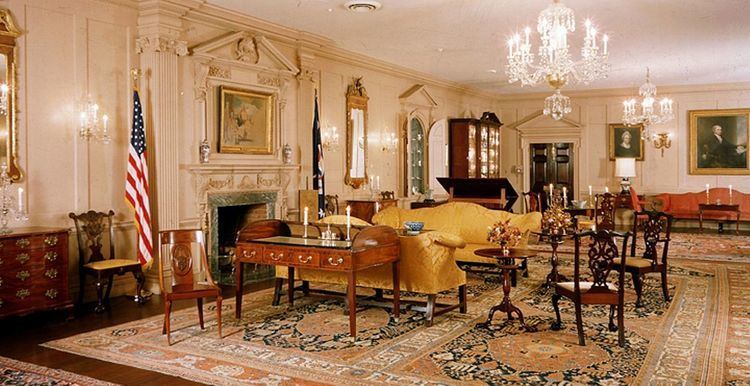 | ||
The Diplomatic Reception Rooms at the U.S. Department of State constitute forty-two principal rooms and offices where the Secretary of State conducts the business of modern diplomacy. Located on the seventh and eighth floors of the Harry S Truman Building in Washington, D.C., the Diplomatic Reception Rooms contain one of the nation’s foremost museum collections of American fine and decorative arts.
Contents
Architect Edward Vason Jones designed several of the rooms between 1965 and 1980. Clement Conger, curator of the collections from 1961 to 1990, assembled many of the art, furniture, and decorative arts objects.
Guided tours of the Diplomatic Reception Rooms are available by appointment. Admission is free. Tours can be scheduled online.
8th floor
7th floor
Collections
Masterpieces in the collections are assembled from the early Federal period, c. 1790-1815. These masterpieces are interwoven into an interpretative narrative that explores U.S. diplomatic history: charting of the new world and the colonial foundations, the nation’s road to independence and birth of the United States, and expansion westward over the years 1740-1840. The Diplomatic Reception Rooms are a national treasure that belongs to the American people. It is the People that support the vital activities of the Diplomatic Reception Rooms. Charitable contributions from private citizens, foundations, and corporations support revitalization and expansion initiatives, collections maintenance and conservation, and educational programming.
On September 3, 1783, the Treaty of Paris, establishing peace with Great Britain after the American Revolutionary War, was signed on this Tambour Writing Table. This diplomatic achievement is depicted in the collection’s unfinished painting, after Benjamin West’s 1782 original, “The American Commissioners of the Preliminary Peace Negotiations with Great Britain.” Hand-wrought silver by patriot-silversmith Paul Revere, porcelain wares from George Washington’s Society of Cincinnati, and companion portraits of John Quincy and Louisa Catherine Adams, 1816, by artist Charles Robert Leslie are among the national treasures.
